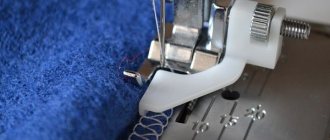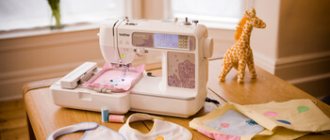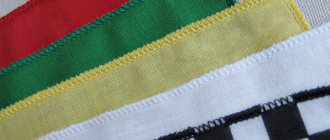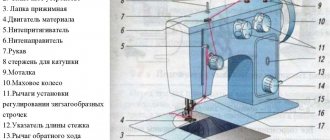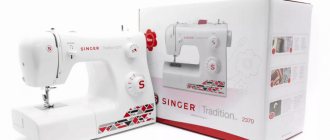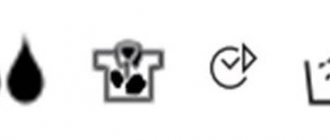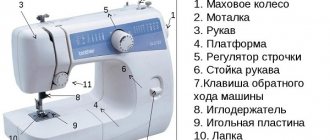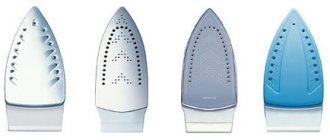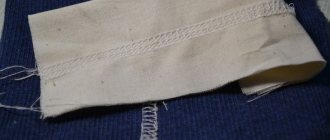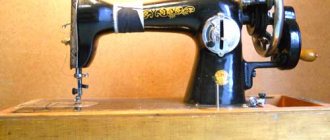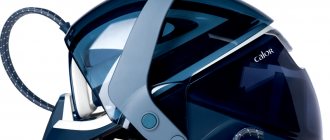What is the presser foot for?
The main purpose of the foot is to press the fabric to the table surface so that when the thread is pulled out, it does not move after it. On a regular household machine, the manufacturer installs a standard foot, with which any needlewoman can make the simplest seams.
But it is not suitable for all materials and not all sewing operations. For example, for sewing on buttons, creating pintucks, and high-quality work with knitwear, leather, very thin or very thick fabrics, you need to use special feet.
What types of paws are there?
Experienced craftswomen know that a correctly selected presser foot and machine operating parameters are the key to an even, beautiful stitch. It is difficult for a beginner to navigate such diversity. A description of interesting auxiliary legs will ease the path to the heights of mastery.
- Basic foot (for sewing and zig-zag stitching). This foot is designed for sewing straight stitches, zigzag stitches and a range of simple basic stitches. It comes with any machine. In simple machines with a small number of lines, this foot is often the only one.
- For bias binding. The foot has a special groove into which the tape is inserted. As the foot moves forward along the fabric, the binding itself folds in half, framing the edge of the fabric. The craftswoman just needs to make sure that the line lies evenly.
- For sewing in a zipper. One side of the foot, which faces the zipper during operation, is slightly narrower than the other. This way, the foot does not catch on the teeth while sewing.
- For sewing in a hidden zipper. It itself is raised and has a groove in the middle. During operation, the presser foot lifts the edge of the zipper, the stitching lies close to the teeth, without forming thickenings.
- For buttons. Machine-sewn buttons hold firmly and look professional and neat. The foot secures the buttons to the fabric. The seam is made in the zig-zag mode with a stitch width equal to the distance between the button holes. In this case, the conveyor must be turned off, and the darning plate must be selected. Before performing the operation, you must make sure that the distance is set correctly, otherwise you may break the needle.
- For knitwear. It is better to sew elastic fabrics on a special machine, on a stitcher. It is difficult to handle knitwear on a regular machine: it is stretched out and the fibers get stuck in the slot of the needle plate. To avoid these troubles, there is a rubberized pad on the foot that prevents the knitwear from sagging during operation.
- To create tucks. It has a serrated leading edge and a wide serrated recess for needles. This foot works exclusively in conjunction with a double needle. This tandem allows you to lay two parallel lines in one movement, for example, for a linen seam or decorative design of darts and reliefs on clothes.
- For a narrow hem. Allows you to create a neat hem on thin, light fabrics like chiffon. Works in conjunction with a fine needle.
- Walking foot. It has a rather complex design. This device allows you to sew voluminous materials equally and to the full depth, for example, to quilt a down jacket. Used for patchwork style work.
- For the cord. This foot allows you to smoothly attach decorative cord, braid, and relief elements to the fabric without prior basting. There is a groove on the bottom surface of the device into which the cord fits. The needle follows the center line of the groove, thus making a perfectly even stitch.
- For a hidden seam. This foot has a special vertical guide bar, which helps to make a hidden seam exactly where it needs to be laid.
- For quilting. Theoretically, decorative stitching can be done with the first foot on the list. However, the presence of a special device simplifies the process. The foot has a translucent cap with markings and an extended base, so the seamstress can see where the stitching is going.
- For circular stitch. Using a toothed circular attachment, it moves the fabric in a perfectly even circle. Such a device can be useful for embroidery or for decorative stitching - quilting.
- For laying two parallel lines. It has a transparent overlay with markings applied to it and a guide. It is convenient for laying parallel lines of any kind.
- Transparent foot. This is a standard foot, but made of transparent plastic. For work that requires high precision and no room for error (for example, when working with luxury fabrics), it allows you to see every movement of the needle. This attachment will be useful for embroidery, decorative stitching and for beginning needlewomen.
- For sewing on beads. The foot is voluminous and has a bead-shaped recess. In order to attach a thread of beads to the fabric, the beads must be laid out on the fabric in the desired pattern, the first bead is inserted into the groove on the foot, the required pitch for the needle is set, then the machine will do everything itself.
- For sewing on sequins. Similar to the previous foot, but has a smaller groove. Allows you to sew the sequin thread evenly. At the same time, the decorations lie in the desired direction, do not break, do not lift up due to the fact that the foot itself distributes them.
- For working in the patchwork technique. Usually this is a whole set of paws. Each of them sews with a certain allowance. By changing devices as needed, you can solve any problem when working in patchwork style.
- For assemblies. It has a complex design and performs a combined operation. She edges the base, gathers the second fabric and joins them together. All in one operation.
- For the fringe. Usually beginners do not have such a paw in their arsenal. It requires some experience. The foot creates a fringe pattern. It is difficult to work with, but the result looks impressive.
What types of paws are there and what are they used for?
Many modern models of household machines are adapted to work with a wide range of sewing feet. In addition to the standard one, the set of accessories usually includes a basic set of several pieces. Their number varies depending on the model of the machine, its cost and manufacturer.
Some models have only 5 pieces, while others have up to 14. You can purchase additional special devices as needed during the operation of the machine.
This accessory can be made of different materials: metal, high-quality polymer, transparent plastic, which largely depends on its purpose. Let's look at the types of feet most used by modern craftswomen.
Standard
All sewing machines are equipped with a universal foot. It is designed to perform two main seams: straight and zigzag with the ability to change the length and width of the stitch. Most needlewomen use only this foot for all sewing situations.
Walking
Designed to ensure uniform feeding of material using a special comb, it does not allow layers to shift on very thin or thick fabrics, including a blanket or down jacket.
The walking foot is also called the upper feed. Helps promote the product not by sliding, but by moving movements.
For bias tape
Allows you to create bias binding with even seams equally spaced on both sides of the edge in one pass.
The snail in the design wraps the fabric and guides it in front of the needle. For different widths of binding, different presser feet are used. If there are several slots of different sizes in the snail, then it is possible to sew on trims of different widths.
For lightning
The zipper foot helps to make an even seam at the same distance from the edge of the zipper without turning the product. Such devices can be single-sided, double-sided, narrow, or for a hidden zipper.
They also differ in the material from which they are made: metal, plastic, Teflon.
For buttons
Using this device, flat buttons with holes are sewn with a zigzag seam at a distance from each other no more than the maximum seam width for a given machine model. The design has rubberized linings so that the buttons do not slip.
Sewing is performed at slow speed with the lower conveyor turned off. Before sewing, you need to make sure that the zigzag distance is set correctly, otherwise the needle will break.
Podrubnaya
It is also called a hemmer, a chopping foot, or a twisting device. It has a curling device and, in one pass, folds the edge of the product in half and sews an even seam without first ironing the folded edges. Can perform hems to different widths.
Knitted
Elastic fabric, such as knitwear, stretch, has the ability to stretch when sewing seams as usual. For an even, beautiful stitch, a knitted foot is required that prevents the material from hanging down and clogging between the teeth of the lower conveyor. It prevents stitch skipping and tearing.
To create tucks
Pintucks are created by sewing with a double needle using a special foot. They are obtained on the product thanks to the grooves on its sole. There can be up to 9 pieces. depending on the model.
The height and thickness of the fold depends on the depth of the grooves. Can be used to create pintucks with insert cords.
For quilting
To stitch the scraps together and embroider them on sewing machines, you can buy a quilting device. With its help it is good to do darning and stitching, to make seams at a given distance and at a certain angle.
That's why these paws are different. For a variety of stitches, you can buy a whole set.
For assemblies
Designed for making soft gathers and flounces of the desired size. The device has two mechanical adjustments, thanks to which you can perform complex assemblies with rarer or more frequent folds. To create gathers, the sole is raised behind the needle and has a thickening in front of the needle. She gathers one fabric in one pass and sews it to another.
For a narrow hem
The design of such a device has a curl that bends the edge in half and immediately creates a beautiful and even seam. Used for thin and delicate fabrics such as chiffon. Does not allow edges to fray. Can be used to process the edges of scarves, shawls, napkins, and household items.
For parallel lines
The foot is made of transparent plastic and has markings that allow it to sew parallel decorative stitches. First, one line is laid. Then it is placed between the red guides on a transparent sole and the second line is sewn parallel to the first.
Teflon
Not found in the standard set. The Teflon foot is designed for working with high-density fabrics. Made of a special polymer that allows you to glide easily when working with leather, suede, velvet, vinyl, and does not cling to the material. Works smoothly and leaves no marks. Does not cope with slippery fabrics.
With limiter
Used for making neat finishing stitches with a uniform indentation from the edge, as well as for wasting products, processing cuts and making a blind seam. Allows you to make standard and decorative seams.
Roller
Used for sewing thick fabrics: leather, suede, corduroy. The roller does not put pressure on the material, displacing it, but easily rolls over uneven layers of fabric, where the seams meet. The roller foot is also used for making decorative stitches; it can make not only straight seams, but also zigzag ones.
Overedge
Helps to overcast the bottom of the material with an even overcast stitch, preventing it from deforming. During operation, several stitches are placed on the tooth located in the center of the needle slot. They come off as the fabric moves and form an even overcast seam.
Types and purpose of sewing machine feet. Part 1.
Author - Alena Izhak, teacher at GRASSER school
The set of modern sewing machines includes a fairly large number of “helpers” - sewing feet. They expand the possibilities and make the sewing process easier. But, frankly, how many of us understand the purpose of each of them? At best, we use two or three, and the rest lie unnecessarily.
So let's figure out why each of them is needed and begin to actively apply them to life.
In stores for household machines you can find more than 40 types of all kinds of paws. And today we will look at those feet that are most often included in the kit of a household sewing machine.
They are used:
· For connecting lines.
· For decorative.
· For working with fabrics of increased complexity.
1. The most popular foot is the zigzag foot.
We all know it very well, since most often we work with it not only using zig-zag, but also a straight stitch or some decorative stitches. There are two varieties of this foot.
The first one has a slot for performing zig-zag up to 5 mm. It is most often included in the kit.
And the second has a slot for zig-zag up to 7 mm wide. It has a small black locking button that allows you to align the presser foot when the fabric thickens.
2. Foot for sewing in a zipper.
This foot is good because its design allows you to get close to the zipper links. It can also be used when sewing strips with buttons, piping or ready-made hooks on tape.
3. Buttonhole foot.
Used for sewing buttonholes in manual and automatic modes. It allows you to set different loop widths depending on the diameter of the button. You can also use it to perform bartacking or darning.
4. Overcasting foot
. It is characterized by the fact that it has a limiter that prevents the fabric from tightening. Not only the edge stitching is performed on it, but also some decorative stitches running along the cut edge of the material.
5. Blindstitch foot.
This foot is used for hemming hems on medium to heavy weight fabrics. On thin fabrics, when using this foot, punctures will be visible on the front side. It is good to use monofilament threads to hem the bottom. To achieve good results, training is necessary.
In the next article we will continue to study the feet, which are often included with modern machines.
In our online store you can buy feet for household sewing machines.
Tips for choosing sewing machine feet
When choosing an accessory, you need to remember that not all paws fit all car models. Therefore, you need to read the list of models, which is in the description of the selected accessory. You should pay attention to the criteria by which presser feet of one brand may not fit a sewing machine from another manufacturer. This:
- fastening method;
- distance from the attachment point to the needle hole;
- height of the foot from the base to the fastening;
- zigzag width;
- the location of the attachment point in relation to the center of the device.
After this, you can go purchase new paws and do not neglect the advice of the seller.
How to use
It's not enough to just change the presser foot, you need to know how to use it. There are some that do not require additional manipulations with devices to use. The fabric is placed on the lower conveyor. The sole is lowered onto the material and you can start sewing. In this case, the seamstress can move and hold the product with her hands in a certain way. It depends on the type of sewing operation.
But there are devices with a complex design, into which you need to tuck the main fabric or finishing material in a certain way. Here are examples:
For a narrow hem, cut the edge of the fabric at an angle of 450 and tuck it into the hem hole.
For tucks, you need to insert the tuck into the notch on the bottom of the sole to guide the next fold.
For bias tape, cut off the corner of the tape and insert the resulting point into the snail, pulling it out behind the paws; place the material for the edging in the cutout on the device.
Why does a seamstress need a walking foot and how to use it
The AURORA brand produces many sewing accessories that significantly expand the capabilities of the equipment and improve the quality of work. In this article you will learn why a walking foot is needed and how to use it when sewing complex and multi-layered materials.
Operating principle of the walking foot or upper feed
Each sewing machine is equipped with a lower conveyor. Its functional task is to move the fabric while maintaining a given stitch length. This element of technology is divided into segments by teeth. When a seamstress works with complex fabrics, for example, silk, chiffon, knitwear, leather or velvet, the machine “acts up”, makes omissions, and the fabric constantly “creeps” to the side. As a result, the seams turn out to be ugly, pulled together, and the pattern does not match. This problem is aggravated when it is necessary to sew several layers of fabric, for example, when stitching or working using the quilting technique (patchwork).
The task of the upper conveyor (the device is also called a walking foot) is to duplicate the movement of the fabric from above. The principle of moving fabric along the length of a stitch on both sides is used in industrial settings. This is why the stitching on factory items looks perfect.
When replacing a regular foot with an upper conveyor, the teeth of the device lower onto the fabric and, in symbiosis with the lower conveyor, move it the length of the stitch. The operation performed is similar to a step, which is why the second name of the upper conveyor is the walking foot.
For what tasks is a walking foot used?
The use of an upper conveyor will greatly facilitate the work with “capricious”, complex fabrics and multi-layer materials. The quality of the stitching will be much higher; the pattern will not shift, since the parts being sewn will move simultaneously. What operations do you need a walking foot for:
- sewing knitwear, thin, very elastic, smooth, sliding and fluffy materials;
- artistic or traditional stitching (for example, sewing products from raincoat fabric, leather);
- work using quilting or patchwork techniques;
- sewing textiles when matching patterns (patterns, checks, stripes) are necessary;
- tailoring of leather, suede, vinyl, laminated and glued fabrics.
When starting to work with complex, especially expensive fabrics, be sure to buy a walking foot. Don't experiment and ruin expensive fabric.
How to choose and where to buy a walking foot
When purchasing a top conveyor, be sure to check whether the selected model is suitable for your machine.
Carefully study the description in the product catalogue. In the AURORA brand assortment you can choose a walking foot for any model of sewing equipment:
- AU-118 (5 mm)
– for working with sliding, heavy materials and fabrics folded in several layers, suitable for stitching leather and knitwear parts, this is the simplest square-shaped model; - AU-134 (7 mm)
– for sewing complex, highly sliding and heavy materials, as well as multi-layer products, rounded design with a hole for a guide – convenient for stitching parallel lines; - AU-152 (7 mm)
- an open model for sewing vinyl fabrics, artificial and natural leather, satin, silk and any other materials, when working with which feeding with a conventional conveyor is difficult, a round-shaped model with a hole for a guide - convenient for stitching parallel lines , plus the open design gives a good overview and convenient markings on the base of the foot for working in patchwork; - AU-115
- a guide that works in tandem with a walking foot, used to perform parallel lines when stitching.
In fact, all the paws presented in the catalog of the AURORA online store perform the same task; the design and additional functionality are slightly different.
Each model prevents movement of parts, provides additional pressure and uniform movement. As a result, the seams are neat, not tight, and the finished product looks no worse than a factory one.
AURORA brand presser feet are suitable for most models of modern sewing machines: Janome, Brother, Bernette, JUKI, Aurora and others. Use additional accessories in your work, sew beautifully and with pleasure.
How to change
Replacing the accessory is easy. Depending on the manufacturer, the mounting method may vary slightly. Most modern machines have a standardized holder. There are two main ways to change presser feet of different configurations.
Replacing only the sole
To do this, lift the foot and needle up and press the lever located at the back of the device. The sole will come off immediately. Place the new one under the holder, lower the rod into the socket of the sole. A characteristic joining sound will follow.
